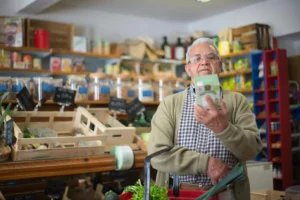
How Sustainable Merch Is Shaping Climate-Conscious Consumer Habits
By Edrian Blasquino
Is sustainable merchandise just a trend? No, it has passed the test of time. This is because people are genuinely becoming more aware of what they buy and how it affects the planet. From eco-friendly apparel to bamboo straws, folks are choosing products that match their views.
Apart from looking good, they want to do good, as well.
Purchasing sustainable merchandise doesn’t just mean changing your style; it signifies a fundamental change in your habits. This article will discuss why this change is happening and how it’s encouraging climate-conscious lifestyles. Let’s begin.
Growth of eco-friendly consumerism
Eco-friendly consumerism is on the rise. Just look at the numbers.
Around 89% of global shoppers now favor more eco-friendly options. What’s more is that 80% of them are willing to pay a bit more for sustainable products. This figure shows that people are truly interested in making better choices for the planet instead of just going after thrifty deals.
A top example is the sustainable fashion market. In 2024, it was valued at around $8.1 billion, but is set to skyrocket to $33.1 billion by 2033. That’s a humongous growth of 22.9% per year. In turn, that means heaps and heaps of recycled threads, organic cotton, and upcycled fabrics landing on shelves.
The younger Millennials and Gen Z are, unsurprisingly, leading this shift. More than their elders, they care about where their purchases come from and what their money supports. Many of them don’t just want style—they want substance. This is especially true for everyday essentials like tote bags and water bottles, as well as themed college apparel—items that now need to reflect both personal style and social responsibility.
Cool designs alone no longer cut it. Students expect merchandise to be made ethically and sustainably, pushing brands to rethink how they produce and market their goods.
Cool designs no longer cut it. Merchandise must be made following ethical practices. This is changing how companies approach production and sustainability.
Impact on buying habits
There’s no denying how sustainable merch is helping push eco-consumerism. In the past half decade, about 72% of shoppers have selected eco-friendly items over run-of-the-mill options. As it turns out, products marketed as sustainable sell about 2.7 times faster than those that aren’t. That huge discrepancy proves that people now care about their choices.
Greener options leave the shelves faster, but that’s not all. These sustainable options also reinforce brand loyalty. Around 70% of businesses report that being eco-friendly has made it easier for them to create stronger relationships with their customers.
However, companies shouldn’t try to trick consumers with disingenuous sustainability claims. When people support a brand, they want to be sure they can be trusted. This is why about 70% of consumers put in the effort to verify sustainability claims.
Consumers aren’t just more committed to their values; they are smarter. They want transparency about the origin of their purchased products. They want to know what it’s made of and how it’s manufactured.
Slapping a green label and calling it a day will only backfire.
Driving climate-conscious lifestyles
As mentioned, turning to sustainable merch is a fundamental change in habits. In other words, a lifestyle shift. Almost half of consumers (46%) are working towards decreasing their environmental impact by choosing greener options.
While others don’t necessarily look for the green label, they are turning their backs on wasteful spending and picking up products with a smaller footprint.
The lifestyle shift doesn’t end with buying a reusable bottle or swapping plastic for bamboo, though it does start there. From small steps, people eventually change their daily habits. They end up making other eco-friendly choices, leaning heavier into this lifestyle.
Some will end up diving into more significant changes, such as using clean energy and going plant-based.
It’s not just the individual. Communities are also participating. Have you noticed the increased presence of thrift markets? Clothing swaps are more common and DIY repair workshops are popping up everywhere. This means people who previously thought sustainable choices were a hassle will be encouraged to make the shift.
The little changes do add up, resulting in a ripple effect that pushes even more people to rethink their consumption habits.
Small steps, big impact
Let’s say that today, you chose to buy a shirt made from sustainable materials and processes. In the grand scheme of things, that choice seems so small. Yet, it’s significant when it comes to making a difference.
You shouldn’t feel pressured to make life-changing decisions overnight. Creating lasting habits takes time. And starting that long journey begins with a small step.
Every green choice you make will add up. Your choices will influence the people around you. Your support will incentivize companies to do better. Eventually, your choice becomes the choice of many.
Together, you reduce demand for resource-heavy production. Together, you significantly reduce your carbon footprint.
And it all started because your favorite brand committed to selling sustainable merchandise.
Final words
As a consumer, it’s pretty clear where you fit in this picture. It’s your values and choices that influence how companies operate. You vote with your money. If not for the rise in environmental awareness, sustainable merch wouldn’t even be a thing. And they wouldn’t last long if people didn’t continue supporting them.
So, are you supporting brands that align with your values, or just grabbing what’s convenient? What will your purchase decisions say about the future you want to see?
EDRIAN BLASQUINO
Edrian is a college instructor turned wordsmith, with a passion for both teaching and writing. With years of experience in higher education, he brings a unique perspective to his writing, crafting engaging and informative content on a variety of topics. Now, he’s excited to explore his creative side and pursue content writing as a hobby.
LinkedIn I Facebook I Portfolio